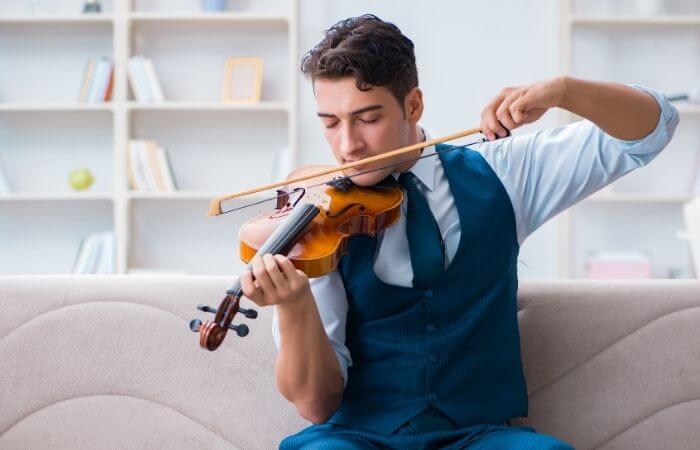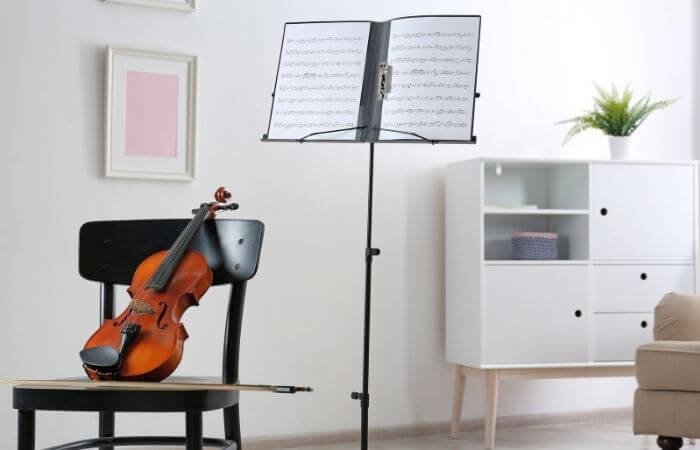Playing the violin requires dedication, diligence and regular practice.
However, practicing at home can be met with limitations as we all know the violin can be loud and other people don’t tend to appreciate hearing hours of violin practice.
Fortunately, you can easily reduce the sound of your violin by using a practice mute, using a silent or electric violin or by taking steps to soundproof the room you practice in.

If you’re just getting started with the violin you may not want people to be able to hear you practising anyway.
These tips will help you practice your violin quietly so the sound won’t disturb others in the home or neighborhood.
1. Use A Practice Mute
A practice mute is a piece of rubber or metal that can be attached to the bridge of the violin.
They basically work by reducing the vibration from the strings to make the instrument quieter.
- The practice mute reduces volume by about 50% which doesn't disturb your neighbors or family
- Put it on the top of bridge, easy to use
- available for 4/4 violin
Using a practice mute will considerably reduce the volume of your violin. Practice mutes are inexpensive and easy to use.
They are perfect for practising at home without disturbing others.
You can get a regular mute or a heavy mute.
A regular mute is circular and is often used when a specific sound is desired while a heavy mute is a rounded square with prongs and is used to make the instrument far quieter to the point of being barely audible.
Rubber Vs Metal Mute
A rubber mute is the more affordable option and is more gentle meaning it is less likely to damage your violin.
The rubber mute will be able to reduce the volume of the violin by around 50%.
Rubber and metal practice mutes produce different tones so you may have a sound preference.
A metal mute is more effective and can reduce the volume by 70-80%. However, some people find it can damage the bridge.
Generally, if you are careful the mute will stay in place and won’t move around or damage the bridge.
To attach the mute place it gently on top of the bridge, never force it onto the violin.
Note: Make sure you pick up a practice mute rather than an orchestra mute as these do different things.
A practice mute can absorb up to 80% of vibrations while an orchestra mute is designed for orchestra performances and may absorb 20% of the vibrations.
Don’t Use The Practice Mute All The Time

While a practice mute is probably the best solution for most situations it is important not to use it all the time.
Using a mute can muffle mistakes and can lead to you playing too loud or too rough.
The tone quality can also be muddied so it’s best to only use the mute when you need to practice quietly.
Make sure you play without a mute so you can build on your bowing and tone creation skills and play well.
Musicians that practice with a mute exclusively often find there are a number of errors that need to be corrected when playing without the mute.
This is simply because you don’t hear a lot of the mistakes when the sound of the violin is being dulled.
2. Use A Silent Violin
A silent violin is designed to produce far less sound than a traditional violin, it does not have a resonating chamber which means there is no body noise.
You will only hear the sound of the bow on the strings. When you play without amplification these violins are close to silent.
A silent violin also allows you to connect headphones for quiet practice sessions.
Make sure the violin has an input jack if you want to practice and play along to songs.
Silent violins are able to be played quietly making them great for practice but they can also be plugged into an amplifier for performances and those times you can enjoy louder music.
A silent violin is a good option but it is expensive. An acoustic violin and a practice mute can be just as effective and far more affordable.
Also Read:
How To Make An Acoustic Guitar Quieter
How To Soundproof A Room For Drums On A Budget
3. Use An Electric Violin
An electric violin is also a viable option for quiet practice as you can plug headphones in so you can hear the practice session but no one else can.

To be able to connect headphones to the violin it needs to have a pre-amp built-in.
4. Think About Where You Are Practising
With the right equipment, you can use any violin to practice without disturbing those around you.
An acoustic violin with a heavy practice mute is perfect for quiet practice but may still penetrate walls and using a silent violin or an electric violin with headphones is unlikely to bother people in other rooms.

To give the best results also consider where you are practicing using the following tips:
Consider Room Layout
When you are deciding where to practice, consider the layout of the rooms.
If possible, choose a room that does not share any walls with neighbors or rooms where the people are you don’t want to disturb e.g. the children’s bedroom or your partner’s study.
Consider Soundproofing
Using a practice mute is great for occasional use but it can lead to bad habits if used all the time.
The sound of the violin can often still be heard through walls when using a mute due to the presence of bass and mid-range frequencies.
If you’re still concerned about the level of noise, soundproofing a room could be your best option.
Soundproofing the room you will be practicing in can not only stop the sound from bothering others outside of the room but will also help make the room quieter for better practice.
- Utilise heavy objects as barriers.
Soundproofing a room can be as simple as placing heavy objects (such as bookshelves) in the space between where you will practice and the shared wall.
- Hang soundproof curtains.
It is also a good idea to hang soundproof curtains over the doors and windows as these will make a big difference by absorbing the excessive ambiance within the room.
There are lots of color and pattern options meaning you can select soundproof curtains that suit the style of the room.
- Install weatherstrips.
Other simple, cost-effective options include installing soundproofing materials such as weatherstripping on the door to prevent noise from coming in and out of the room.
- Install acoustic panels.
Finally, you may want to consider installing acoustic panels.
These are great for insulating high or low frequencies and are very quick and easy to install.
You may want to cover just one wall (the shared wall that connects rooms for example) or you may want to soundproof the entire room. Acoustic panels are a great option for either of these needs.
In Summary: Practicing The Violin Quietly
As you can see, your music lessons don’t have to stop because you’re stuck at home.
These tips will have you practicing as much as you like and at any time of day without disturbing anyone.
Many of the above solutions are quick, simple and cost-effective so you can enjoy playing your violin in no time.
As an Amazon Associate I may earn a small fee from qualifying purchases at no extra cost to you. This helps us run the site, so thanks for your support!

